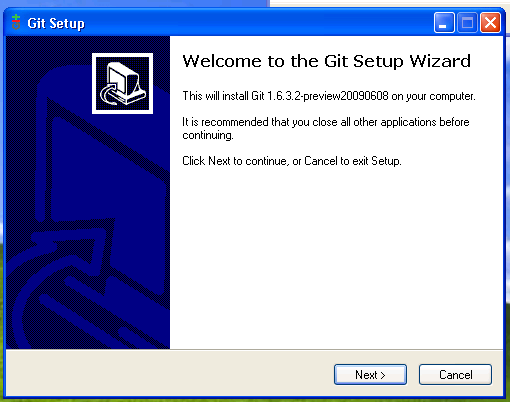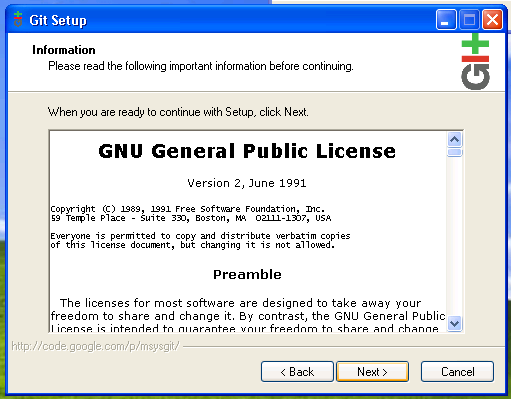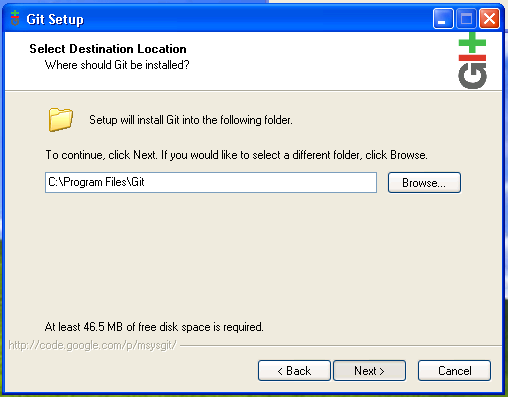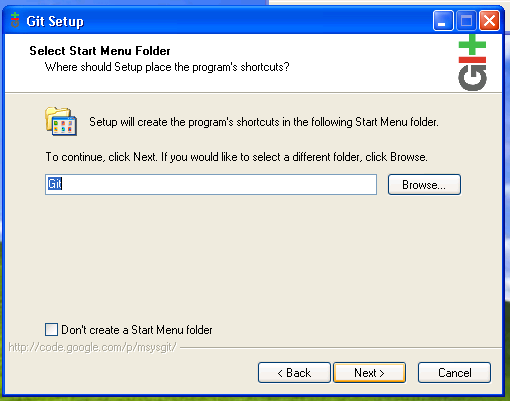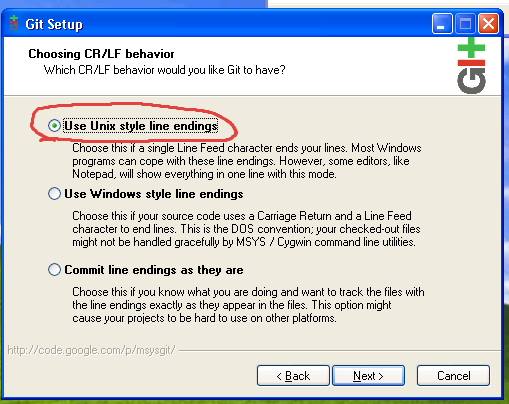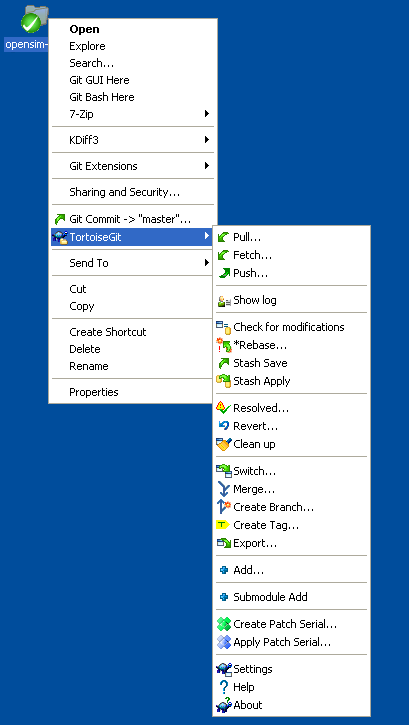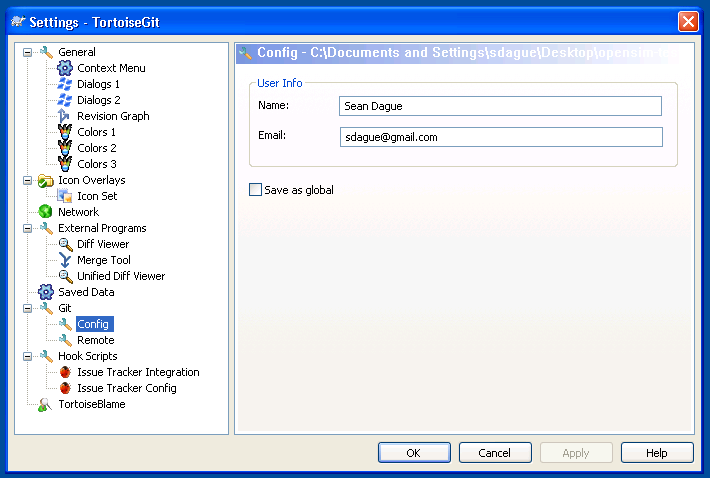OpenSimGerman/Update mit Git
From OpenSimulator
(→Konzeptionelle Veränderungen zu Subversion) |
|||
| Line 79: | Line 79: | ||
= Konzeptionelle Veränderungen zu Subversion = | = Konzeptionelle Veränderungen zu Subversion = | ||
| − | Distributed source code | + | Distributed source code ist ein wesentlich anderes modell zur zentralisierten source code Verwaltung. Nicht verzweifeln, am Anfang ist es für jeden etwas gewöhnungsbedürftig. Dieses [http://betterexplained.com/articles/intro-to-distributed-version-control-illustrated/ blog posting] ist das Beste das ich jeh zu disem Thema gesehen habe. |
| − | + | Der eingefleischte SVN Benutzer sollte diese Page lesen[http://git.or.cz/course/svn.html git / svn cheat sheet]. Es ist eine Solide Basis um Ihre Anpassungen zu machen. | |
* Terminologie | * Terminologie | ||
** master ist der name der primären upstream branch (bei subversion trunk genannt) | ** master ist der name der primären upstream branch (bei subversion trunk genannt) | ||
** origin ist der name und die location von dem Sie Ihren Klon gezogen haben | ** origin ist der name und die location von dem Sie Ihren Klon gezogen haben | ||
| − | * | + | * Versionsnummern sind SHA1 hashes, keine sequentiellen Nummern. Man benutzt in der Regel die ersten 6-8 digits der hash um mit Ihnen zu arbeiten. |
| − | + | ||
* Committing | * Committing | ||
| − | ** commits | + | ** commits sind lokal. Das heisst, sie sind schnell. Alle Konflikte werden werden während des nächsten pull geklärt. Das ist ein wesentlicher Unterschied zum SVN modell von subversion. |
** by default only files you explicitly '''git add''' are put into the commit. To get '''svn ci''' equivalency use '''git commit -a''' to commit all outstanding files (I think tortoise handles this for you) | ** by default only files you explicitly '''git add''' are put into the commit. To get '''svn ci''' equivalency use '''git commit -a''' to commit all outstanding files (I think tortoise handles this for you) | ||
| − | ** | + | ** nach einem commit müssen Sie das Ergebnis auf ein remot repository '''push'''en(normalerweise origin). |
| − | + | ||
| − | + | ||
= Gegenüberstellung Git --- SVN Befehle = | = Gegenüberstellung Git --- SVN Befehle = | ||
Revision as of 10:23, 12 August 2009
Dies ist eine Anleitung zur Verwendung von Git für OpenSim core Entwickler.
Installieren von Git
Linux
CLI
- Git ist ein Package das für alle modernen Linux Distributionen vorhanden ist. Installieren Sie die folgenden Packages entsprechend Ihrer OS-Umgebung:
- Debian, Ubuntu:
apt-get install git-core
- Centos: Anleitung unter http://www.how-to-linux.com/2009/01/install-git-161-on-centos-52/
- Debian, Ubuntu:
GUIs
- git-gui
- Debian, Ubuntu:
$ sudo apt-get install git-gui $ git gui
- git-cola
- Debian, Ubuntu:
$ apt-get install git-cola $ git-cola
Windows
Unter Windows benötigen Sie 2 Komponenten:
- msysgit - Das Grundmodul für Windows. Installieren Sie dieses zuerst.
- Tortoise Git - Der Git Explorer. Installieren Sie dieses als zweites Modul.
Wenn Sie msysgit installieren vergewissern Sie sich, dass Sie Unix style line endings aktiviert haben. Damit wird sichergestellt das die Zeilen-Endekennung richtig interpretiert werden, und gemischte Ergebnisse in Zukunft vermieden werden.
Git Konfiguration
Git hat eine globale wie eine lokale Konfiguration für jedes Repository. Als Erstes ist es wichtig dass Sie Ihre Emailadresse und Ihren Namen der im System benutzt werden soll wie folgt bekannt geben.
Linux:
git config user.email Deine@EMAIL.ADDR git config user.name "Dein Name"
Unter Windows benutze das Konfigurationsmenü wie folgt:
Git Repositories für OpenSim
Hier die Repository Url's:
| Repository | Developer URL | User URL |
|---|---|---|
| opensim (main repository) | ssh://opensimulator.org/var/git/opensim | git://opensimulator.org/git/opensim |
Klonen des Repositry (für Core Developers)
Wenn Du ein Core Developer bist benutze die Developer URL von oben. Wenn Du kein Core Developer bist , benutze die User Url. Das erzeugen des ersten Klones kann einige Minuten in Anspruch nehmen, da das komplette Repository mit der ganzen history erzeugt und geladen wird.
Anders als mit svn können Sie mehrere Quellen definieren, von denen Sie Daten ziehen können. Wenn Sie zuerst mit einem User tree (welcher nur read only ist), können Sie später den core tree (oder einen anderen tree vom github) benutzen.
Linux
Benutzen Sie die folgende Kommandozeile:
git clone ssh://opensimulator.org/var/git/opensim
Dieses legt ein Test-Verzeichnis opensim an.
Windows
Mausklick rechts auf den Desktop (oder wo auch immer) und 'Git Clone...'
Wenn Sie nach einer Url gefragt werden geben Sie bitte folgende ein ssh://opensimulator.org/var/git/opensim. Dein Username und Dein Passwort werden dann benutzt für opensimulator.org.
Klonen des Repositry (für Nicht Core Developers)
Benutze die selbe Vorgehensweise wie oben, nur anstatt der Nutzung der ssh:// Url benutze die git:// Url. Dies ist das Äquivalent zum anonymen svn Zugang.
Konzeptionelle Veränderungen zu Subversion
Distributed source code ist ein wesentlich anderes modell zur zentralisierten source code Verwaltung. Nicht verzweifeln, am Anfang ist es für jeden etwas gewöhnungsbedürftig. Dieses blog posting ist das Beste das ich jeh zu disem Thema gesehen habe.
Der eingefleischte SVN Benutzer sollte diese Page lesengit / svn cheat sheet. Es ist eine Solide Basis um Ihre Anpassungen zu machen.
- Terminologie
- master ist der name der primären upstream branch (bei subversion trunk genannt)
- origin ist der name und die location von dem Sie Ihren Klon gezogen haben
- Versionsnummern sind SHA1 hashes, keine sequentiellen Nummern. Man benutzt in der Regel die ersten 6-8 digits der hash um mit Ihnen zu arbeiten.
- Committing
- commits sind lokal. Das heisst, sie sind schnell. Alle Konflikte werden werden während des nächsten pull geklärt. Das ist ein wesentlicher Unterschied zum SVN modell von subversion.
- by default only files you explicitly git add are put into the commit. To get svn ci equivalency use git commit -a to commit all outstanding files (I think tortoise handles this for you)
- nach einem commit müssen Sie das Ergebnis auf ein remot repository pushen(normalerweise origin).
Gegenüberstellung Git --- SVN Befehle
Hier eine Schnellanleitung zur Benutzung von Git als Versionsverwaltung für core developer. Für normale Benutzer funktionieren diese Befehle genauso, es muss lediglich die Git:// anstatt der ssh:// URL benutzt werden.
Hier die Unix Kommandozeilenbefehle. Diese Befehle sind auch im Kontextmenü von Tortoise git vorhanden.
Ziehen des Quellcodes
git clone ssh://opensimulator.org/git/opensim-test
Dies ist das Äquivalent zu svn co
Note: Alle anderen Anweisung erwarten das Du Dich im git Verzeichnis befindest.
Updaten Deines checkout
git pull
Dies ist das Äquivalent zu svn update
Kontrolliert Veränderungen im working tree
git status
Dies ist das Äquivalent zu svn status
Übertragen einer Änderung
Beispiel:
git add file1 file2 ...
git commit
oder
git commit -a
Pushen der commiteten Änderungen
Beim ersten mal müssen Sie eine Bracnh zuweisen die Sie pushen wollen.
git push origin master
Nach dem ersten mal reicht ein simples git push , und git weiss dass master syncronisiert werden muss zu origin.
Achtung: commits in git sind lokal. Sie sind nicht verfügbar im Main Tree solange Du Sie nicht mit push bereit stellst. Das heisst, Sie können offline Änderungen vornehmen und diese später mit dem Netz syncronisieren.
Das Checkout auf eine spezielle Revision setzen
git reset --hard #HASHVALUE
Dieses gibt Ihnen dei Möglichkeit ganz bestimmte Versionen zu nutzen. Dies ist das Äquivalent zu svn up -R#version.
git reset dient natürlich auch um Versionensänderungen zurückzusetzen.
Resetten des tree auf master (i.e. trunk)
git pull
pro vorgehen
Erzeugen eines Patch
git format-patch #HASHVALUE
This will create a patch suitable for attaching or emailing from a single commit. You can also specify a range of commits.
Dies ist am nächsten zu svn diff > patchfile.txt für nicht übertragene patches in subversion.
Applying a Git Patch
If someone has formatted a git patch you can apply it directly (including all file adds, file mode changes, and their change log entry) with:
git apply patchfile.patch
Reverting a Change
git revert #HASHVALUE
This directly reverts the change, with a commit message stating that fact. There is no svn direct equiv, though this is often accomplished through: svn diff -R revisions > revert.patch && patch -p0 < revert.patch && svn ci -m "reverting revisions"
Resetting part of the tree to master
git checkout -- file1 file2 ...
Checkout is an operation that populates the working directory from the git repository. Doing a git checkout (master is the implied branch) -- file1 file2 repulls those files from the git repo, clobbering them in your local directory. This is like svn revert.
Diffing Changes
Against your most recently committed changes
git diff
From your most recent changes to a past change
git diff #HASHVALUE
Between any 2 changes
git diff #HASHVALUE1 #HASHVALUE1
Branches
Erzeugen ein Branch
To create a new branch based on the current one, do:
git branch <branchname>
Changing Branches
To change between branches do:
git checkout <branchname>
Tracking a Branch
If you want to work on a specific branch, you can track it, by creating a local version of it on which you can pull and push. If you have already pulled (or fetched) from origin, you should have all remote branches names:
git branch -a
Will show all branches, local and remote. Choose a remote branch to track then do:
git branch --track <localbranchname> origin/remote/<remotebranchname>
A new local branch will be created created, which will push and pull to the specific remote branch.
